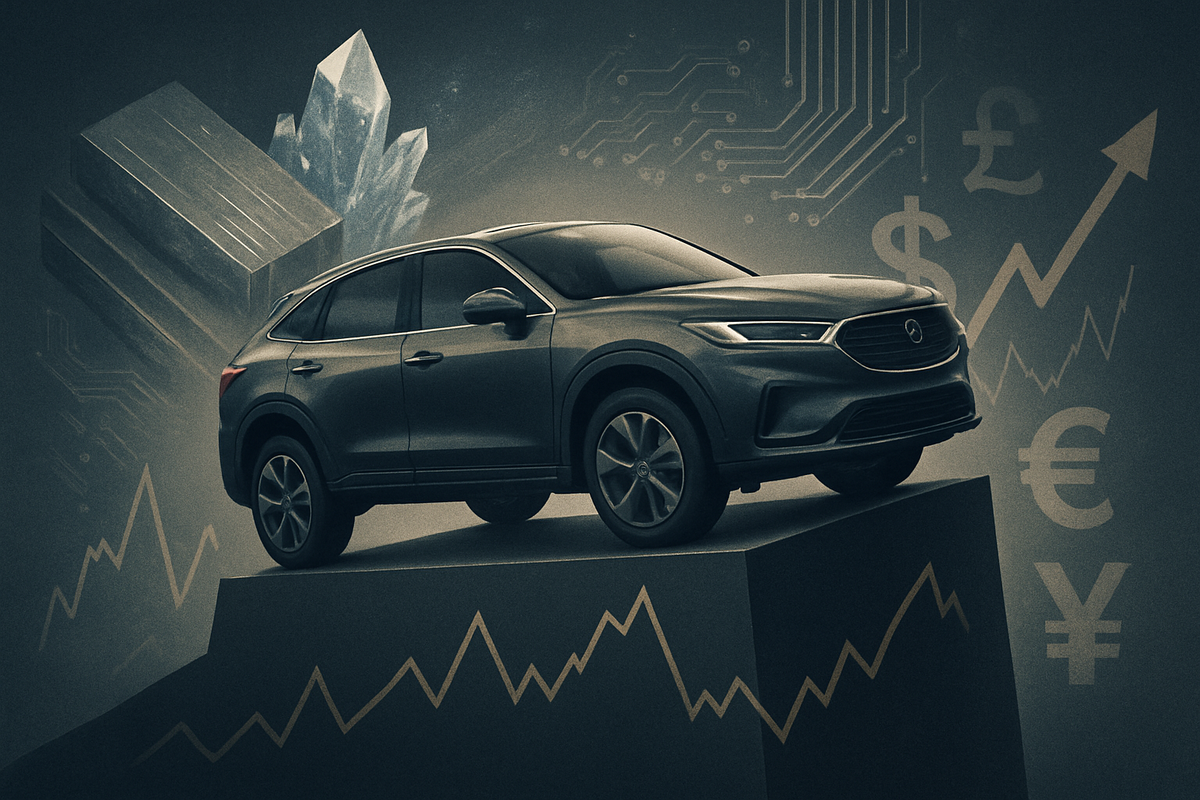
The global automotive industry is bracing for a significant surge in passenger vehicle (PV) prices in 2026, a development poised to reshape consumer purchasing habits and redefine manufacturers' strategic priorities. This anticipated increase is not an isolated event but rather the culmination of persistent inflationary pressures on key commodities, the disruptive force of exchange rate volatility, and the escalating impact of global trade tariffs. As the industry navigates this complex landscape, consumers should prepare for higher vehicle costs, while automakers grapple with the delicate balance of maintaining profitability and market share.
This upward trajectory in vehicle pricing is projected to continue, with various analyses forecasting a 2-8% rise in new car prices across the board for 2026. While electric vehicle (EV) prices might see a more nuanced trend due to declining battery costs and intense competition, the overall market is set for an era of heightened cost. This shift presents a "perfect storm of challenges" for the sector, demanding innovative solutions and a re-evaluation of long-standing business models.
The Confluence of Costs: Tariffs, Commodities, and Currency Swings Drive Up Production Expenses
The projected increase in passenger vehicle prices for 2026 is rooted in a multifaceted interplay of economic and geopolitical factors that have steadily elevated automakers' production costs. A primary driver is the re-imposition and increase of tariffs, particularly by the U.S. government on imported auto parts, steel, and aluminum. These tariffs are expected to add approximately $5,500 to the average cost of an imported vehicle and around $1,000 to U.S.-assembled vehicles due to tariffs on parts. General Motors (NYSE: GM) reported a $1.1 billion impairment in Q2 2025 due to tariffs, while Stellantis (NYSE: STLA) incurred $350 million in tariff-related costs in H1 2025, underscoring the immediate financial burden on manufacturers.
Beyond tariffs, critical commodity prices continue to exert upward pressure. The automotive sector's insatiable demand for semiconductors remains a challenge, with shortages, especially for mature node chips (40 nanometers and above) crucial for automotive applications, expected to persist through 2026. Demand for automotive semiconductors is projected to triple by 2030, driven by the rise of electromobility and advanced driver-assistance systems (ADAS). Lithium, a vital component for EV batteries, is forecast to recover in price in 2026 after a period of decline, with a potential market flip from glut to deficit. While battery costs are projected to fall below $100 per kilowatt-hour by 2026, the underlying commodity price recovery will still factor into overall EV costs. Steel and aluminum prices, also subject to tariffs, continue to fluctuate, with global steel demand expected to rebound by 1.3% in 2026, and aluminum prices potentially extending their rally.
Exchange rate volatility further complicates the cost equation for global automakers. Fluctuations in major currencies like the USD, EUR, JPY, and CNY directly impact the cost of imported components and raw materials. A depreciating currency in a manufacturing country can inflate input costs, squeezing profit margins. For instance, a stronger yen can negatively affect the export revenue of Japanese automakers like Toyota (NYSE: TM) when converted back to their home currency. Automakers often employ financial hedging strategies to mitigate these risks, but overall volatility remains a significant challenge. The U.S. Dollar Index has shown volatility throughout 2024, creating inverse correlations with metals valuations and impacting producer margins.
The timeline leading to this juncture includes the initial global semiconductor shortage (2021-2023), followed by renewed tariffs and persistent inflation in 2024-2025. This period also saw a significant spike and subsequent plummet in lithium prices. As of late 2025, concerns about semiconductor shortages for mature nodes have resurfaced, alongside projections for overall new car price increases of 4-8% by the end of 2025, setting the stage for 2026. Automakers like Volkswagen (XTRA: VOW) have already announced price hikes for most 2026 models (2.9% to 6.5%), with others like Ford (NYSE: F) increasing prices on specific models affected by tariffs. Many manufacturers are implementing "quiet hikes" by bundling new tech and luxury features into higher trims to mask direct price increases, while simultaneously focusing on supply chain realignment and localization to build resilience.
Navigating the Volatility: Winners and Losers in the Automotive Sector
The anticipated price increases in 2026 will undoubtedly create a distinct divide within the public automotive sector, separating companies poised for resilience and growth from those likely to face significant headwinds. Success will hinge on strategic positioning, robust risk management, and adaptive business models.
Likely "Winners" will be companies characterized by strong domestic supply chains, effective hedging strategies, and diversified portfolios. Automakers that have invested heavily in localizing their production and sourcing within major markets, such as those with significant manufacturing footprints in North America or Europe, will be better insulated from tariffs and global supply chain disruptions. Hyundai (KRX: 005380), with its investments in U.S. production capacity, exemplifies this strategic move. Such localization reduces reliance on imports subject to duties, leading to more stable component costs and helping to maintain or improve profit margins. Furthermore, companies with robust commodity and currency hedging programs, like European automakers Volkswagen (XTRA: VOW) and BMW (XTRA: BMW), will be better equipped to manage price volatility. Hedging provides predictability in input costs, protecting profit margins from sudden spikes in raw materials and exchange rate fluctuations. Lastly, firms with diversified portfolios, extending beyond traditional vehicle sales into EV components, aftermarket services, or across different geographical markets, tend to show higher average margins and more stable returns, offering resilience against market downturns. Leaders in EV and ADAS technology with in-house capabilities could also emerge as winners, securing supply and commanding premium pricing for advanced offerings.
Conversely, Likely "Losers" will be those heavily exposed to volatile inputs, lacking robust risk management, or slow to adapt. Automakers and suppliers with substantial reliance on imported components from regions subject to high tariffs will see their production costs rise significantly. Even U.S. automakers like Ford (NYSE: F) and General Motors (NYSE: GM) face critical domestic supply gaps requiring imports, making them vulnerable. Higher input costs, which may not be fully offset by price increases due to consumer affordability limits, will squeeze profit margins. Companies without effective commodity and currency hedging will be directly exposed to unpredictable fluctuations in raw material prices (steel, aluminum, lithium) and exchange rates, making financial planning difficult and eroding profitability. Furthermore, firms with concentrated product portfolios, particularly those heavily reliant on traditional internal combustion engine (ICE) vehicle sales without a strong pivot to EVs or diversified services, may struggle as consumer preferences shift. Their inability to adapt to new technologies and pivot supply chains could lead to a loss of market share and depressed stock valuations.
A Broader Ripple: Industry Transformation and Consumer Adaptation
The anticipated 2026 passenger vehicle price increases are more than just a momentary blip; they represent a significant inflection point, accelerating broader industry transformations and necessitating profound shifts in consumer behavior. This event fits squarely into ongoing trends of cautious consumer spending, intensified focus on supply chain resilience, and a nuanced evolution of EV adoption.
One of the most significant ripple effects will be on EV adoption. While overall vehicle prices are increasing, EV prices could potentially decrease by 3-8% in 2026 due to declining battery costs (potentially reaching below $100/kWh) and fierce competition. This could bring EVs closer to price parity with gasoline-powered cars in some markets. However, the phase-out of federal incentives on many EV models, combined with lingering concerns about charging infrastructure and potential overproduction, could still temper adoption rates. This creates a bifurcated market where ICE vehicle prices rise due to input costs and regulatory burdens, while EV prices fall due to technological advancements and competitive pressures, potentially leading to EV price wars.
Supply chain resilience will become an even more critical differentiator. The current cost pressures underscore the vulnerabilities of globalized supply chains. Automakers are actively diversifying production, shifting manufacturing to countries like Mexico and South Korea, and expanding domestic facilities to mitigate tariff impacts and reduce reliance on single regions. This strategic shift, while costly upfront, aims to build more robust and localized supply chains, ultimately influencing component costs and vehicle pricing. The continued shortages of critical items like chips, sensors, and battery materials further highlight the ongoing need for supply chain optimization and strategic partnerships.
Consumer behavior is already adapting. A significant portion of consumers (nearly two-thirds in a Deloitte survey) perceive new vehicles as unaffordable. Higher prices, coupled with elevated interest rates, are leading many to delay new vehicle purchases and hold onto their current cars for longer periods, with the average age of a light vehicle in the U.S. reaching 12.8 years in 2025. This trend will likely boost demand for aftermarket services and used cars, potentially driving up prices in the pre-owned market. A new segment of "value-seeking" consumers is emerging, prioritizing affordability and scrutinizing whether new or pre-owned purchases deliver real value, potentially increasing demand for more economical models or longer-term financing solutions.
Historically, the automotive industry has faced similar periods of intense cost pressure. The 1970s oil crises forced a dramatic shift towards fuel-efficient vehicles, challenging American automakers to compete with more economical imports. The 2008 Financial Crisis highlighted how economic shocks can decimate demand and necessitate government intervention. More recently, the post-COVID-19 pandemic era (2020-2024) saw unprecedented supply chain disruptions, particularly the semiconductor chip shortage, leading to skyrocketing new and used car prices. The current anticipated increases for 2026 can be seen as a continuation of these post-pandemic cost pressures, now compounded by inflation and tariffs, reinforcing the industry's vulnerability to external shocks and its continuous need for adaptation. Regulatory bodies may also face pressure to intervene with new incentives or trade policy adjustments to address affordability and market stability.
The Road Ahead: Strategic Shifts and Emerging Scenarios
The automotive industry stands at a pivotal juncture, with the anticipated 2026 price increases necessitating profound strategic pivots from automakers and a redefinition of the consumer-vehicle relationship. Both short-term adaptations and long-term visions will be crucial for navigating this evolving landscape.
In the short term, automakers will prioritize aggressive cost-cutting measures, including lean manufacturing principles, greater automation, and optimization of software development processes. Supply chain diversification will accelerate, with a shift away from a singular "just-in-time" model towards more localized and redundant sourcing strategies to build resilience against disruptions and tariffs. New material sourcing, particularly for critical EV battery components like lithium, will involve securing long-term contracts. For consumers, the immediate future suggests continued exploration of leasing and the used car market as alternatives to new vehicle purchases, while anticipating that new EV models might offer more competitive pricing.
Looking to the long term, the industry is undergoing a fundamental transformation into a "software-driven" sector, where software increasingly defines vehicle features and user experience. This necessitates significant investment in robust software architectures that enable constant upgrades, new digital services, and over-the-air updates. Automakers will also continue to expand product portfolios to include more affordable EV models and diversify powertrain offerings with hybrids and even hydrogen fuel cells. The rise of "Mobility-as-a-Service" (MaaS) and subscription-based mobility solutions could also gain traction, catering to evolving consumer preferences and reducing reliance on traditional ownership models. This period also presents market opportunities in the growing EV sector, new revenue streams from software and connectivity, and the burgeoning autonomous driving market, despite challenges like intense competition from new entrants and talent shortages.
Several potential scenarios could unfold. In a "Moderate Price Hikes" scenario, new car prices rise modestly, leading consumers to adapt through leasing or extending vehicle lifespans, while automakers leverage efficiency gains and new software-driven revenues. A "Significant Price Increases Leading to Market Contraction" scenario could see higher-than-expected price hikes severely impacting affordability, leading to a significant drop in new car sales, intense margin pressure for automakers, and potential industry consolidation. Alternatively, a "Bifurcated Market with EV Price Wars" could emerge, where ICE vehicle prices rise, but EV prices fall aggressively due to declining battery costs and fierce competition, accelerating EV adoption while challenging profitability for some manufacturers. Finally, a "Software and Service Dominance" scenario envisions automakers successfully transitioning to software-defined vehicles, generating substantial recurring revenue from digital services, making hardware a less significant profit driver.
The New Normal: A Market Redefined and What Investors Should Watch
The anticipated 2026 passenger vehicle price increases mark a definitive shift towards a "new normal" in the automotive market. The era of readily affordable new vehicles may be further receding, ushering in a period where vehicle ownership becomes less accessible for a segment of the population. This structural change could bolster demand for public transportation, ride-sharing, or, most notably, a prolonged ownership cycle of older vehicles, benefiting the aftermarket services sector.
The "recalibration" of the EV market is a critical takeaway. While the long-term global trajectory toward electrification remains firm, the immediate challenges of affordability, coupled with the scaling back of some manufacturer commitments, signal a more measured, consumer-driven adoption phase. This will likely foster greater innovation in battery technology and production efficiency to genuinely lower costs, and a stronger focus on the used EV market as an entry point for many consumers. The increased competition from Chinese EV manufacturers, offering more affordable models, will also likely influence global pricing strategies and accelerate the drive for cost-effectiveness.
Ultimately, this period could lead to a more polarized market. Premium and technologically advanced vehicles will continue to command high prices, catering to affluent buyers. Simultaneously, a growing segment of consumers will seek maximum value, prolonging the lifespan of existing vehicles or opting for more basic, cost-effective new and used options.
For investors, with the current date of November 14, 2025, several key indicators warrant close monitoring in the coming months:
- Affordability Metrics and Consumer Spending: Watch for continued trends in average transaction prices, auto loan interest rates, and loan terms. Any further significant increases in the "weeks of income to purchase a new vehicle" metric could signal deeper demand erosion.
- Inventory Levels: Monitor new and used vehicle inventory. While some brands like Cadillac and Jeep are seeing rising inventories, overall overstocking could force discounting, impacting manufacturer margins. Conversely, continued tightness in the used car market will sustain higher prices.
- Tariff Developments and Supply Chain Resilience: Keep an eye on any new tariff announcements or adjustments to existing trade policies, as these directly impact production costs and pricing strategies. Also, observe how effectively automakers are diversifying their supply chains and integrating AI for better risk management.
- EV Market Performance: Differentiate between new and used EV sales. Track the success of new, more affordable EV models coming to market, and the growth trajectory of the used EV segment. Pay attention to battery cost trends, as further declines could improve new EV competitiveness.
- Manufacturer Strategies: Observe how major automakers adjust their product mix (e.g., more hybrids, fewer niche EVs), production locations, and investment in R&D, particularly concerning electrification and autonomous driving technologies. Shifts towards "local-for-local" production to mitigate tariff risks will also be important.
- Regional Market Dynamics: Recognize that trends may vary by region due to local incentives, infrastructure, and consumer preferences.
The coming months will be crucial in determining the full extent of these shifts. Companies demonstrating agility in adapting to evolving consumer demands, managing cost pressures, and strategically navigating the EV transition will be best positioned for sustained success in this transforming automotive landscape.
This content is intended for informational purposes only and is not financial advice


















